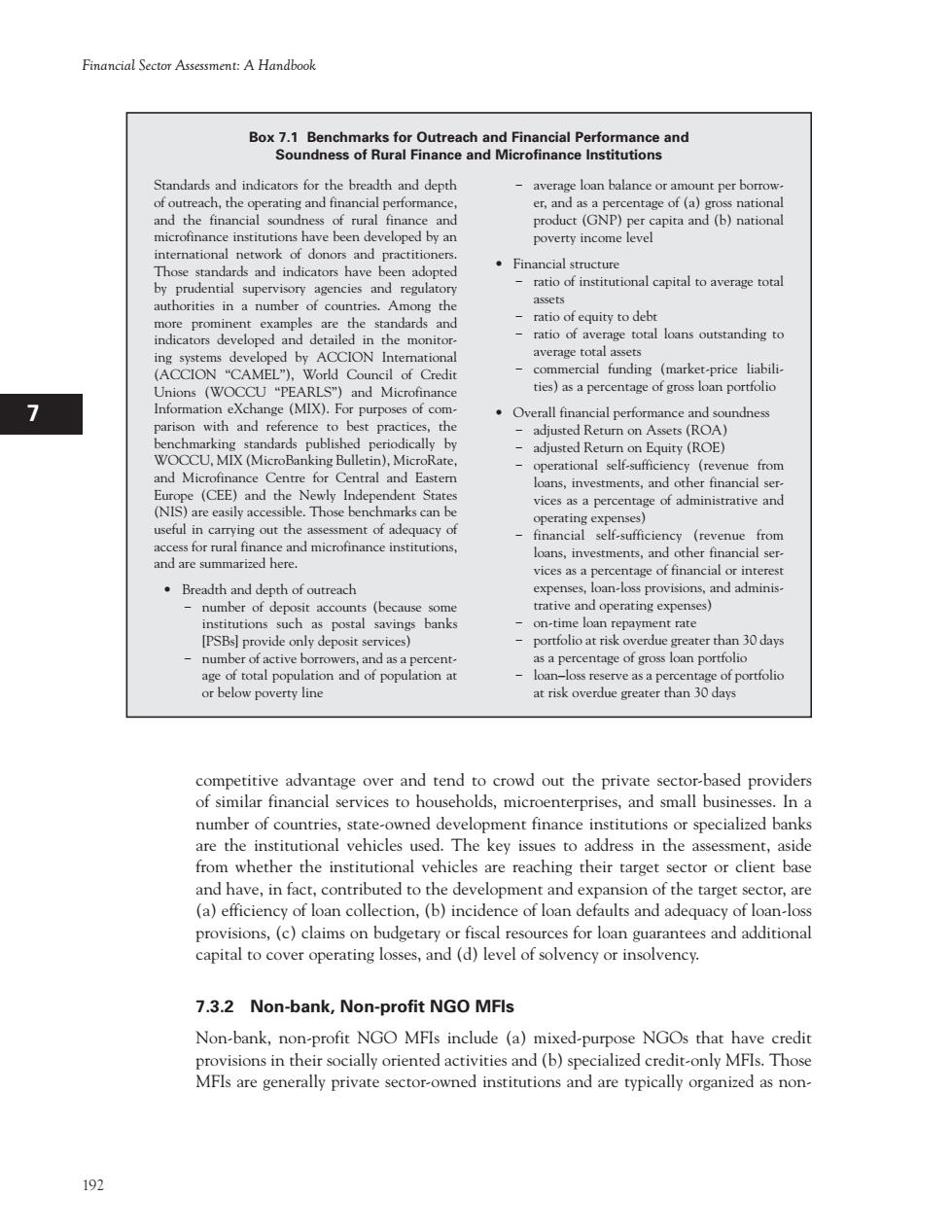正在加载图片...

Financial Sector Assessment:A Handbook Box 7.1 Benchmarks for Outreach and Financial Performance and Soundness of Rural Finance and Microfinance Institutions and product (GNP)per capita and (b)national poverty income level an of equty to deb ratio of ge total loans outstanding to d ne (marke liabili ndness () rks can be vices as a percentage of administrative and fron loans,invest .Breadth and depth of ou L number of de it accounts(because tative and operating expe nt rat n 30 day number of active borrowers,and asa as a perc competitive advantage over and tend to crowd out the private sector-based providers of similar financial services to households,microenterprises,and small businesses.In a number of countries,state-owned development finance institutions or specialized banks are the institutional vehicles used.The key issues to address in the assessment.aside from whether the institutional vehicles are reaching their target sector or client base and have,in fact,contributed to the development and expansion of the target sector,are (a)efficiency of loan collection,(b)incidence of loan defaults and adequacy of loan-loss ver operating lo 7.3.2 Non-bank,Non-profit NGO MFls ose NGOs that have credit ecalecdc redit-only MFls.Tho 192192 Financial Sector Assessment: A Handbook 1 I H G F E D C B A 12 11 10 9 8 7 6 5 4 3 2 competitive advantage over and tend to crowd out the private sector-based providers of similar financial services to households, microenterprises, and small businesses. In a number of countries, state-owned development finance institutions or specialized banks are the institutional vehicles used. The key issues to address in the assessment, aside from whether the institutional vehicles are reaching their target sector or client base and have, in fact, contributed to the development and expansion of the target sector, are (a) efficiency of loan collection, (b) incidence of loan defaults and adequacy of loan-loss provisions, (c) claims on budgetary or fiscal resources for loan guarantees and additional capital to cover operating losses, and (d) level of solvency or insolvency. 7.3.2 Non-bank, Non-profit NGO MFIs Non-bank, non-profit NGO MFIs include (a) mixed-purpose NGOs that have credit provisions in their socially oriented activities and (b) specialized credit-only MFIs. Those MFIs are generally private sector-owned institutions and are typically organized as nonBox 7.1 Benchmarks for Outreach and Financial Performance and Soundness of Rural Finance and Microfinance Institutions Standards and indicators for the breadth and depth of outreach, the operating and financial performance, and the financial soundness of rural finance and microfinance institutions have been developed by an international network of donors and practitioners. Those standards and indicators have been adopted by prudential supervisory agencies and regulatory authorities in a number of countries. Among the more prominent examples are the standards and indicators developed and detailed in the monitoring systems developed by ACCION International (ACCION “CAMEL”), World Council of Credit Unions (WOCCU “PEARLS”) and Microfinance Information eXchange (MIX). For purposes of comparison with and reference to best practices, the benchmarking standards published periodically by WOCCU, MIX (MicroBanking Bulletin), MicroRate, and Microfinance Centre for Central and Eastern Europe (CEE) and the Newly Independent States (NIS) are easily accessible. Those benchmarks can be useful in carrying out the assessment of adequacy of access for rural finance and microfinance institutions, and are summarized here. • Breadth and depth of outreach − number of deposit accounts (because some institutions such as postal savings banks [PSBs] provide only deposit services) − number of active borrowers, and as a percentage of total population and of population at or below poverty line − average loan balance or amount per borrower, and as a percentage of (a) gross national product (GNP) per capita and (b) national poverty income level • Financial structure − ratio of institutional capital to average total assets − ratio of equity to debt − ratio of average total loans outstanding to average total assets − commercial funding (market-price liabilities) as a percentage of gross loan portfolio • Overall financial performance and soundness − adjusted Return on Assets (ROA) − adjusted Return on Equity (ROE) − operational self-sufficiency (revenue from loans, investments, and other financial services as a percentage of administrative and operating expenses) − financial self-sufficiency (revenue from loans, investments, and other financial services as a percentage of financial or interest expenses, loan-loss provisions, and administrative and operating expenses) − on-time loan repayment rate − portfolio at risk overdue greater than 30 days as a percentage of gross loan portfolio − loan–loss reserve as a percentage of portfolio at risk overdue greater than 30 days